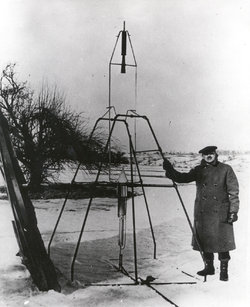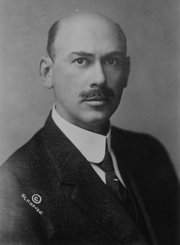Robert Goddard (scientist)
|
|
Robert Hutchings Goddard (October 5, 1882 – August 10, 1945) was one of the pioneers of modern rocketry. Though his work in the field was revolutionary, he was often ridiculed for his theories, which were ahead of their time. He received little recognition during his own lifetime, but would eventually come to be called the "father of modern rocketry" for his life's work.
| Contents |
Early life and inspiration
Goddard was born in Worcester, Massachusetts. He became interested in space when he read H.G. Wells's science fiction classic The War of the Worlds when he was 16 years old. His dedication to pursuing rocketry became fixed on October 19, 1899. While climbing a cherry tree to cut off dead limbs, he imagined, as he later wrote, "how wonderful it would be to make some device which had even the possibility of ascending to Mars, and how it would look on a small scale, if sent up from the meadow at my feet." [1] (http://www.tylerlee.org/robertgoddard.htm) For the rest of his life he observed October 19 as "Anniversary Day", a private holiday.
Education and early work
After receiving his B.S. degree from Worcester Polytechnic Institute in 1908, he was a Fellow in Physics at Clark University, receiving his A.M. in 1910 and his Ph.D. in 1911. By 1914, he was designing rocket motors, with financial assistance from the Smithsonian Institution. By 1919, he was writing about the possibilities of Moon flight.
Goddard launched the first liquid-fueled rocket on March 16, 1926 at Auburn, Massachusetts. His journal entry of the event was notable for its laconic understatement: "The first flight with a rocket using liquid propellants was made yesterday at Aunt Effie's farm." The rocket, which was dubbed "Nell" and about the size of a human arm, rose just 41 feet during a 2.5-second flight that ended in a cabbage field, but it was an important demonstration that liquid-fuel propellants were possible.
Not all of Goddard's early work was geared towards space travel. He developed the basic idea of the bazooka and, using a music rack for a launcher, demonstrated the weapon at Aberdeen Proving Ground two days before the Armistice that ended World War I. Another Clark University researcher continued Goddard's work on the bazooka, leading to the weapon used in World War II.
Contemporary criticism of Goddard
Goddard was suspicious of others and often worked alone, which limited the ripple effect from his work. His unsociability was a result of the harsh criticism that he received from the media and from other scientists, who doubted the viability of rocket travel in space. After one of his experiments in 1929, a local Worcester newspaper carried the headline "Moon rocket misses target by 238,799 1/2 miles."
Most notable however was the, retrospectively funny, response of The New York Times to Goddard's landmark 1919 paper, "A Method of Reaching Extreme Altitudes." The Times lambasted his research because "everybody knows" rockets won't travel in the vacuum of space, where there's nothing to push against. Goddard, the article claimed, "seems to lack the knowledge ladled out daily in high schools."

Later work and World War II
Eventually Goddard relocated to Roswell, New Mexico—long before the area became the center of the UFO craze—where he worked in near isolation for decades, and where a high school was later named after him. Though he brought his work in rocketry to the attention of the United States Army, he was rebuffed, as the Army largely failed to grasp the military application of rockets.
Ironically, it was Nazi Germany that took the most interest in his research. Wernher von Braun relied on Goddard's plans when he developed the V-2 rockets during World War II [2] (http://scienceworld.wolfram.com/biography/Goddard.html). Before 1939, German scientists would occasionally even contact Goddard directly with technical questions. In 1963, von Braun, reflecting on the history of rocketry, said of Goddard: "His rockets . . . may have been rather crude by present-day standards, but they blazed the trail and incorporated many features used in our most modern rockets and space vehicles" [3] (http://history.msfc.nasa.gov/vonbraun/recall.html).
After his offer to develop rockets for the Army was declined, Goddard temporarily gave up his preferred field to work on experimental aircraft for the U.S. Navy. After the war ended, Goddard was able to inspect captured German V-2s, many components of which he recognized. However, Goddard would not design any more rockets of his own. He learned he had throat cancer in 1945 and died that year on August 10, the day after the atomic bomb was dropped on Nagasaki, Japan.
Legacy
In 1969, just days before the Apollo 11 Moon landing, the New York Times retracted the editorial it had published in 1920 about Goddard. "Further investigation and experimentation," said the paper, "have confirmed the findings of Isaac Newton in the 17th century, and it is now definitely established that a rocket can function in a vacuum as well as in an atmosphere. The Times regrets the error."
Goddard was awarded 214 patents for his work, most of them coming after his death. He died in Baltimore, Maryland and is buried in Hope Cemetery in his hometown of Worcester. The Goddard Space Flight Center, established in 1959, is named in his honor.
Media
Template:Multi-video start Template:Multi-video item Template:Multi-video end
See also
Quotations
- "It is difficult to say what is impossible, for the dream of yesterday is the hope of today and the reality of tomorrow." (From his high school graduation oration, "On Taking Things for Granted", June 1904)
- "On the afternoon of October 19, 1899, I climbed a tall cherry tree and, armed with a saw which I still have, and a hatchet, started to trim the dead limbs from the cherry tree. It was one of the quiet, colorful afternoons of sheer beauty which we have in October in New England, and as I looked towards the fields at the east, I imagined how wonderful it would be to make some device which had even the possibility of ascending to Mars. I was a different boy when I descended the tree from when I ascended for existence at last seemed very purposive." (Written later, in an autobiographical sketch)
- "Every vision is a joke until the first man accomplishes it; once realized, it becomes commonplace." (His response to the New York Times, 1920)

